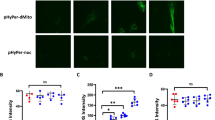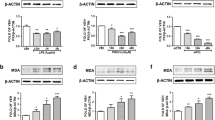Abstract
We hypothesized that: (a) S-nitrosylation of metallothionein (MT) is a component of pulmonary endothelial cell nitric oxide (NO) signaling that is associated with an increase in labile zinc; and (b) NO mediated increases in labile zinc in turn reduce the sensitivity of pulmonary endothelium to LPS-induced apoptosis. We used microspectrofluorometric techniques to show that exposing mouse lung endothelial cells (MLEC) to the NO-donor, S-nitrosocysteine, resulted in a 45% increase in fluorescence of the Zn2+-specific fluorophore, Zinquin, that was rapidly reversed by exposure to the Zn2+ chelator, NNN′N′-tetrakis-(2-pyridylmethyl)ethylenediamine; TPEN). The absence of a NO-mediated increase in labile Zn2+ in MLEC from MT-I and -II knockout mice inferred a critical role for MT in the regulation of Zn2+ homeostasis by NO. Furthermore, we found that prior exposure of cultured endothelial cells from sheep pulmonary artery (SPAEC), to the NO-donor, S-nitroso-N-acetylpenicillamine (SNAP) reduced their sensitivity to lipopolysaccharide (LPS) induced apoptosis. The anti-apoptotic effects of NO were significantly inhibited by Zn2+ chelation with low doses of TPEN (10 μM). Collectively, these data suggest that S-nitrosylation of MT is associated with an increase in labile (TPEN chelatable) zinc and NO-mediated MT dependent zinc release is associated with reduced sensitivity to LPS-induced apoptosis in pulmonary endothelium.
Similar content being viewed by others
References
Stamler JS, Lamas S, Fang FC: Nitrosylation: The prototypic redoxbased signaling mechanism. Cell 106: 675–683, 2001
Pearce LL, Wasserloos K, St. Croix CM, Gandley R, Levitan ES, Pitt BR: Metallothionein, nitric oxide and zinc homeostasis in vascular endothelial cells. J Nutr 130: 1467S–1470S, 2000
St. Croix CM, Wasserloos KJ, Dineley KE, Reynolds IJ, Levitan ES, Pitt BR: Nitric oxide-induced changes in intracellular zinc homeostasis are modulated by metallothionein/thionein. Am J Physiol: Lung Cell Mol Physiol 282: L185–L192, 2002
Kim Y-M, Bombeck CA, Billiar TR: Nitric oxide as a bifunctional regulator of apoptosis. Circ Res 84: 253–256, 1999
Ceneviva GD, Tzeng E, Hoyt DG, Yee E, Gallagher A, Englehardt JF, Kim Y-M, Billiar TR, Pitt BR: Nitric oxide inhibits lipopolysaccharide induced apoptosis in pulmonary artery endothelial cells. Am J Physiol: Lung Cell Mol Physiol 19: L717–L728, 1998
Tzeng E, Kim Y-K, Pitt BR, Lizonova A, Kovesdi I, Billiar TR: Adenoviral transfer of the inducible nitric oxide synthase gene blocks endothelial cell apoptosis. Surgery 122: 255–263, 1997
Kim Y-M, de Vera ME, Watkins SC, Billiar TR: Nitric oxide protects cultured rat hepatocytes from tumor necrosis factor α-induced apoptosis by inducing heat shock protein 70 expression. J Biol Chem 272: 1402–1411, 1997
Fukamachi Y, Karasaki Y, Sugiura T, Itoh H, Abe T, Yamamura K, Higashi K: Zinc suppresses apoptosis of U937 cells induced by hydrogen peroxide through an increase in Bcl-2/Bax ratio. Biochem Biophys Res Commun 246: 364–369, 1998
Mannick JB, Miao XQ, Stamler JS: Nitric oxide inhibits Fas-induced apoptosis. J Biol Chem 272: 24125–24128, 1997
Chung H-T, Pae H-O, Choi B-M, Billiar TR, Kim Y-M: Nitric oxide as a bioregulator of apoptosis. Biochem Biophys Res Commun 282: 1075–1079, 2001
Wyllie AH: Apoptosis: An overview. Br Med Bull 53: 451–465, 1997
Kroncke KD, Fehsel K, Schmidt T, Zenke FT, Dasting I, Wesener JR, Betterman H, Breunig KD, Kolb-Bachofen V: Nitric oxide destroys zinc-sulfur clusters inducing zinc release from metallothionein and inhibition of the zinc finger-type yeast transcription activator LAC9. Biochem Biophys Res Commun 200: 1105–1110, 1994
Cuajungco MP, Lees GJ: Nitric oxide generators produce accumulation of chelatable zinc in hippocampal neuronal perikarya. Brain Res 799: 118–129, 1998
Tang Z-L, Wasserloos K, St. Croix CM, Pitt BR: Role of zinc in pulmonary endothelial cell response to oxidative stress. Am J Physiol: Lung Cell Mol Physiol 281: L243–L249, 2001
Michalska AE, Choo KHA: Targeting and germ-line transmission of a null mutation at the metallothionein I and II loci in mouse. Proc Natl Acad Sci USA 90: 8088–8092, 1993
Dong QG, Bernasconi S, Lostaglio S, De Calmonovici RW, Martin-Padura I, Breviarion F, Garlanda C, Ramponi S, Mantovani A, Vecchi A: A general strategy for isolation of endothelial cells from murine tissues: Characterization of two endothelial cell lines from the murine lung and subcutaneous sponge implants. Arterioscler Thromb Vasc Biol 17: 1599–1604, 1997
Hoyt DG, Mannix RJ, Rusnak JM, Pitt BR, Lazo JS: Collagen is a survival factor against LPS-induced apoptosis in cultured sheep pulmonary artery endothelial cells. Am J Physiol 13: L171–L177, 1995
Arndt-Jovin DJ, Jovin TM: Analysis and sorting of living cells according to deoxyribonucleic acid content. J Histochem Cytochem 25: 585–589, 1977
Pitt BR, Schwarz M, Woo ES, Yee E, Wasserloos K, Tran S, Weng W, Mannix RJ, Watkins SA, Tyurina YY, Tyurin VA, Kagan VE, Lazo JS: Overexpression of metallothionein decreases sensitivity of pulmonary endothelial cells to oxidant injury. Am J Physiol: Lung Cell Mol Physiol 273: L856–L865, 1997
Coyle P, Zalewski PD, Philcox JC, Forbes IJ, Ward AD, Lincoln SF, Mahadevan I, Rofe AM: Measurement of zinc in hepatocytes by using a fluorescent probe, zinquin: Relationship to metallothionein and intracellular zinc. Biochem J 303: 781–786, 1994
Zalewski PD, Millard SH, Forbes IJ, Kapaniris O, Slavotinek A, Betts WH, Ward A D, Lincoln SF, Mahadevan I: Video image analysis of labile zinc in viable pancreatic islet cells using a specific fluorescent probe for zinc. J Histochem Cytochem 42: 877–884, 1994
Truong-Tran AQ, Carter J, Ruffin R, Zalewski PD: New insights into the role of zinc in the respiratory epithelium. Immunol Cell Biol 79: 170–177, 2001
Kroncke KD: Zinc finger proteins as molecular targets for nitric oxide mediated gene regulation. Antioxid Redox Signal 3: 565–575, 2001
Kröncke KD, Kolb-Bachofen V: Measurement of nitric oxide-mediated effects on zinc homeostasis and zinc finger transcription factors. Meth Enzymol 301: 126–135, 1999
Moellering D, McAndrew J, Patel RP, Cornwell T, Lincoln T, Cao X, Messina JL, Forman HJ, Jo H, Darley-Usmar VM: Nitric oxide-dependent induction of glutathione synthesis through increased expression of gamma-glutamylcysteine synthetase. Arch Biochem Biophys 358: 74–82, 1998
Matthews JR, Botting CH, Panico M, Morris HR, Hay RT: Inhibition of NF-kappaB DNA binding by nitric oxide. Nucleic Acids Res 24: 2236–2242, 1996
Brorson JR, Schumacker PT, Zhang H: Nitric oxide acutely inhibits neuronal energy production. J Neurosci 19: 147–158, 1999
Berendji D, Kolb-Bachofen V, Meyer KL, Grapenthin O, Weber H, Wahn V, Kroncke KD: Nitric oxide mediates intracytoplasmic and intranuclear zinc release. FEBS Lett 405: 37–41, 1997
Gross SS, Wolin MS: Nitric oxide: Pathophysiological mechanisms. Annu Rev Physiol 57: 737–769, 1995
Malinski T, Taha Z, Grunfeld S, Patton S, Kapturczak M, Tomboulian P: Diffusion of nitric oxide in the aorta wall monitored in situ by porphyrinic microsensors. Biochem Biophys Res Commun 193: 1076–1082, 1993
Kim YM, Chung HT, Simmons RL, Billiar TR: Cellular non-heme iron content is a determinant of nitric oxide-mediated apoptosis, necrosis, and caspase inhibition. J Biol Chem 275: 10954–10961, 2000
Okuno S, Shimizu S, Ito T, Nomura M, Hamada E, Tsujimoto Y, Matsuda H: Bcl-2 prevents caspase-independent cell death. J Biol Chem 273: 34272–34277, 1998
Zech B, Wilm M, van Eldik R, Brune B: Mass spectrometric analysis of nitric oxide-modified caspase-3. J Biol Chem 274: 20931–20936, 1999
Fahrni CJ, O'Halloran TV: Aqueous coordination chemistry of quinoline-based fluorescence probes for the biological chemistry of zinc. J Am Chem Soc 121: 11448–11458, 1999
Frederickson CJ, Hernandez MD, McGinty JF: Translocation of zinc may contribute to seizure-induced death of neurons. Brain Res 480: 317, 1989
Hennig B, Meerarani P, Toborek M, McClain CJ: Antioxidant-like properties of zinc in activated endothelial cells. J Am Coll Nutr 18: 152–158, 1999
Hennig B, Toborek M, McClain CJ: Antiatherogenic properties of zinc: Implications in endothelial cell metabolism. Nutrition 12: 711–717, 1996
Choi DW, Koh JY: Zinc and brain injury. Annu Rev Neurosci 21: 347, 1998
Meerarani P, Ramadass P, Toborek M, Bauer HC, Hennig B: Zinc protects against apoptosis of endothelial cells induced by lineolic acid and tumor necrosis factor alpha. Am J Clin Nutr 71: 81–87, 2000
Szuster-Ciesielska A, Stachura A, Slotwinska M, Kaminska T, Sniezko R, Paduch R, Abramczyk D, Filar J, Kandefer-Szerszen M: The inhibitory effect of zinc on cadmium induced cell apoptosis and reactive oxygen species (ROS) production in cell cultures. Toxicol 145: 159–171, 2000
Szuster-Ciesielska A, Lokaj I, and Kandefer-Szerszen M: The influence of cadmium and zinc ions on the interferon and tumor necrosis factor production in bovine aorta endothelial cells. Toxicol 145: 135–145, 2000
Lizard G, Deckert V, Dubrez L, Moisant M, Gambert P, Lagrost L: Induction of apoptosis in endothelial cells treated with cholesterol oxides. Am J Pathol 148: 1625–1638, 1996
Cohen JJ, Duke RC: Glucocorticoid activation of a calcium-dependent endonuclease in thymocyte nuclei leads to cell death. J Immunol 132: 38–42, 1984
Perry DK, Smyth MJ, Stennicke HR, Salvesen GS, Duriez P, Poirier GG, Hannun YA: Zinc is a potent inhibitor of the apoptotic protease, caspase-3. A novel target for zinc in the inhibition of apoptosis. J Biol Chem 25: 18530–18533, 1997
Chai F, Truong-Tran AQ, Ho LH, Zalewski PD: Regulation of caspase activation and apoptosis by cellular zinc fluxes and zinc deprivation: A review. Immunol Cell Biol 77: 272–278, 1999
Morana SJ, Wolf CM, Li J, Reynolds JE, Brown MK, Eastman A: The involvement of protein phosphatases in the activation of ICE/CED-3 protease, intracellular acidification, DNA digestion, and apoptosis. J Biol Chem 271: 18263–18271, 1996
Author information
Authors and Affiliations
Rights and permissions
About this article
Cite this article
Tang, ZL., Wasserloos, K.J., Liu, X. et al. Nitric oxide decreases the sensitivity of pulmonary endothelial cells to LPS-induced apoptosis in a zinc-dependent fashion. Mol Cell Biochem 234, 211–217 (2002). https://doi.org/10.1023/A:1015930927407
Issue Date:
DOI: https://doi.org/10.1023/A:1015930927407




